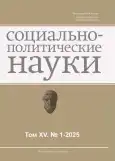Causes and nature of changes in modern warfare
- Authors: Kazakov D.V.1
-
Affiliations:
- Military University named after Prince Aleksander Nevsky of the Ministry of Defense of the Russian Federation
- Issue: Vol 15, No 1 (2025)
- Pages: 157-163
- Section: Social and Political Philosophy
- URL: https://journals.eco-vector.com/2223-0092/article/view/679181
- DOI: https://doi.org/10.33693/2223-0092-2025-15-1-157-163
- EDN: https://elibrary.ru/JPZFAG
- ID: 679181
Cite item
Abstract
The purpose of this article is to survey the approaches to analyzing the primary causes of the transformation of warfare in modern conditions, characterized by transition to a new technological paradigm in which digitalization, in conjunction with nano-, bio-, cognitive, and social technologies, plays a leading role. Digitalization generates transformation of warfare, affecting both its classical and non-classical forms. This factor intersects with the contest among globalization projects, within which the primary belligerents are subjects of globalization opposing subjects of nation-states and local civilizations.
Full Text
About the authors
Dmitry V. Kazakov
Military University named after Prince Aleksander Nevsky of the Ministry of Defense of the Russian Federation
Author for correspondence.
Email: ph.d.kazakov@mail.ru
SPIN-code: 3938-2611
adjunct, Department of Philosophy and Religious Studies
Russian Federation, MoscowReferences
- Barratt J. Humanity’s latest invention: Artificial intelligence and the end of the era of Homo sapiens. Moscow: Alpina non-fiction, 2015. 304 p.
- Beskaravayny S. The existence of technology and singularity. Moscow: RIPOLL Classic, 2018. 476 p.
- Bryant L.R. The democracy of objects. Perm: Gile Press, 2019. 320 p.
- Bychenkov M.V. War. In: New Philosophical encyclopedia. In 4 vols. Moscow: Mysl, 2000. Vol. 1. P. 425.
- Vodzyansky S.I. The multi-sphere battle as a result of the evolution of joint actions of various types of the US armed forces in the XX–XXI centuries. Military Thought. 2023. No. 8. Pp. 125–133. (In Rus.)
- Gibbson W. Peripheral devices. St. Petersburg: ABC; ABC-Atticus, 2023. 448 p.
- Grinyaev S.N. Battlefield – cyberspace: Theory, techniques, means, methods and systems of information warfare. Minsk: Harvest, 2004. 448 p.
- Zuboff S. The era of supervisory capitalism. The battle for the human future at the new frontiers of power. A.F. Vasiliev (transl. from English). Moscow: Gaidar Institute Publishing House, 2022. 784 p.
- Clausewitz K. About the war. Moscow; St. Petersburg: Eksmo: Terra Fantastica, 2003. 864 p.
- Creveld M. Transformation of war. Moscow: Alpina Business Books, 2005. 344 p.
- Kurilkin A.V. Information operations and cyber warfare: From history to the present. Moscow: Hotline - Telecom, 2023. 164 p.
- Kurochko M.M. Nonclassical wars of the modern era: Towards a problem statement. Security Issues. Bulletin of the Scientific Research Center “Science-XIX”. 2008. No. 3. Pp. 24–25. (In Rus.)
- Kurpatov A.V. The Fourth World War. The future is near! St. Petersburg: Capital, 2019. 400 p.
- Kutyrev V.A. Carried away by progress: The eschatology of life in the technogenic world. St. Petersburg: Aleteya, 2016. 300 p.
- Larina E.S., Ovchinsky V.S. Cyber wars of the XXI century. What Edward Snowden was silent about. Moscow: Knizhny Mir, 2014. 352 p.
- Ma Huateng. China’s digital transformation. The experience of transforming the infrastructure of the national economy. Moscow: Intellectual Literature, 2019. 250 p.
- McLuhan M. War and peace in the global village. Moscow: ACT; Astrel, 2012. 219 p.
- McLuhan M. Gutenberg’s Galaxy: The creation of man by the printed culture. Kiev: Nika-Center, 2004. 432 p.
- McLuhan M. Understanding Media: External human extensions. Moscow; Zhukovsky: CANON-press-Ts; Kuchkovo Pole, 2003. 464 p.
- Marcuse G. One-dimensional man. Moscow: REFL-book, 1994. 368 p.
- Marcy K. Flashing: How to protect your brain in the digital age. Transl. from English. Moscow: Alpina non-fiction, 2023. 398 p.
- Mikhailov D.V. The war of the future: A possible order of attack by means of a US air attack in a multi-sphere operation at the turn of 2025–2030. Aerospace Forces. Theory and Practice. 2019. No. 12. Pp. 44–52. (In Rus.)
- Muller D. The tyranny of indicators: How obsession with numbers threatens education, healthcare, business and government. Translated from English. M.: Alpina Publ., 2019. 266 p.
- Pitron G. The Third Digital War: Energy and rare metals. Moscow: ACT, 2021. 320 p.
- Rogovsky E.A. Cyber-Washington: Global ambitions. Moscow: International Relations, 2014. 848 p.
- Savin L. Arrows of the centaur. Cyberwar in the American way. Moscow: Oxygen, 2020. 496 p.
- Sibel T. Digital transformation. How to survive and succeed in the new era. Moscow: Mann, Ivanov and Ferber, 2021. 256 p.
- Skinner K. The digital Man. The fourth revolution in human history, which will affect everyone. Moscow: Mann, Ivanov and Ferber, 2019. 304 p.
- Stuchinsky V.I., Korolkov M.V. Ways to counteract the implementation of the concept of the USA and NATO “multi-domain battle”. Military Thought. 2021. No. 7. Pp. 41–49. (In Rus.)
- Toffler E. Shock of the future. Moscow: ACT, 2001. 557 p.
- Transhumanism: Digital Leviathan and Golem civilization. Moscow: Knizhny Mir, 2021. 320 p.
- Friedman L. Strategy: War, revolution, business. Moscow: Kuchkovo pole, 2018. 767 p.
- Friedmen T. Discworld: A brief history of the XXI century. Moscow: ACT; ACT Moscow: Guardian, 2006. 601 p.
- Friedmen T. Discworld 3.0. A brief history of the 21st century. Moscow: ACT, 2014. 636 p.
- Fukuyama F. Our posthuman future: Consequences of the biotechnological revolution. Moscow: ACT; Lux, 2004. 349 p.
- Harari Yu.N. Homo Deus. A brief history of the future. A. Andreev (transl. from English). Moscow: Sinbad, 2018. 496 p.
- If you want peace, defeat the rebel war! The creative legacy of E.E. Messner. Moscow: Military University; Russian Way, 2005. 696 p.
- Khrenov I.V., Kiryushin A.N., Andreev V.V. Transformation of the concept of “global strike” and approaches to its implementation in practice in the US Armed Forces in modern conditions. Aerospace Forces. Theory and Practice. 2021. No. 18. Pp. 31–45. (In Rus.)
- Shamayu G. Theory of the drone. Moscow: Adam Press; Garage Museum of Modern Art, 2020. 280 p.
Supplementary files











